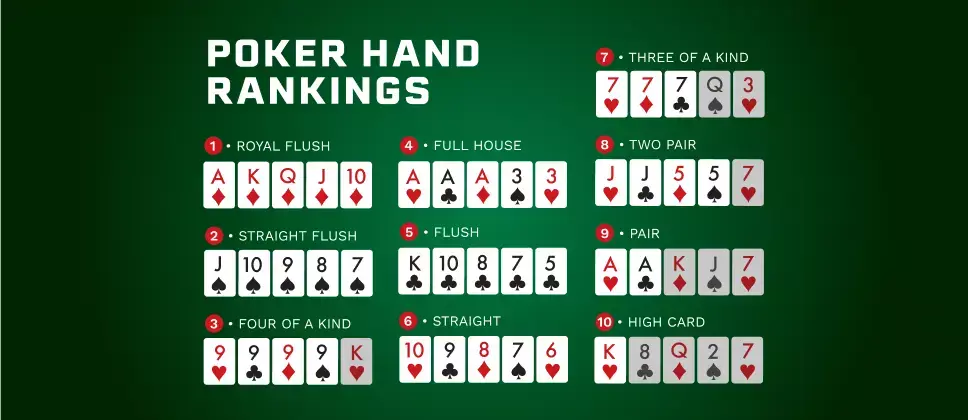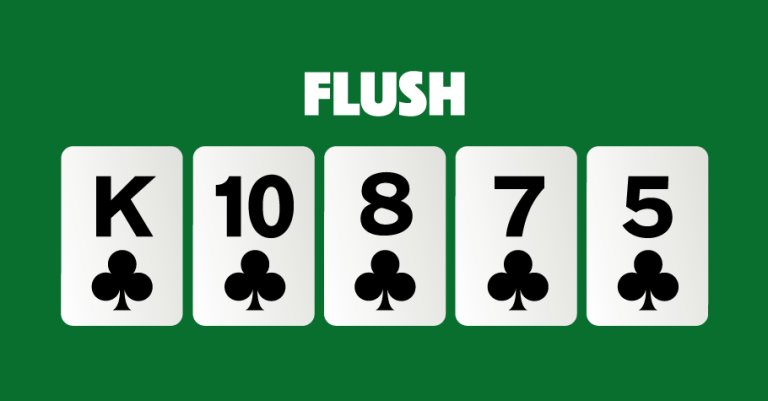
Awareness of poker hands by heart is the bloodline of regular players. It not only helps players aim high but also work towards the most favorable hand for a winning pot. In the line of hands in most poker variants, a flush draw is one of the strongest hands to augment the efforts to win a pot. But flush poker rules are often obscure for most players during the play. They try trial and error to come across a flush draw to make it through.
But honing a flush can be an art with the right amount of awareness of how it works. We will learn how to get five cards to stand on the same suit, which is what a flush is in poker, along with a few thumb rules. Rest assured, it should set you up for the win.
What is a Flush Poker?
A flush hand occurs when a player has five cards of the same suit. It is one of the strongest hands in poker and increases the player's chances of winning the pot.
Let's understand flush poker meaning through its origin. The word flush is derived from the Latin word “Fluxus”, which means flowing. The flow of a single suit in five cards thus constitutes a flush.
The consecutiveness of denominations is unnecessary for a flush, but their suit determines the winning flush. 10-8-7-5-2, A-J-10-7-5 and 8-6-3-2-A of the same suit are examples of flush hands in poker. The type of suit doesn't matter as long as all five cards have the same suit.
Hand Rankings Chart

Mastering the rankings is the key to winning when playing poker online.
What is a straight flush poker? When a flush has consecutive cards of the same suit, it is known as a straight flush. 10-9-8-7-6 or A-K-Q-J-10 is a straight flush hand in poker.
Most people wonder what is powerful in straight vs flush poker. A flush poker game always beats a simple straight hand.
How Does a Flush Hand Rank?
The rank of flush poker hands is 5 in the poker hand rankings chart. They are below the royal flush, straight flush, four-of-a-kind, and full house. This also means that a flush poker hand beats a straight, three-of-a-kind, two pair, one pair, and high card hands that rank below it.

Among flush poker hands, the ranking is based on the highest-ranking cards, irrespective of the suit. When there is a tie of high-ranking cards, the second-highest card is selected to determine the winner. For example, observe the below flushes:
A♠J♠10♠3♠2♠
A♣K♣Q♣8♣2♣
7♥5♥3♥2♥A♥
Q♦J♦10♦9♦3♦
What is the highest ranking flush among these? The flush hands with ace-high cards beat the remaining two. Among the two ace-high hands, A♠J♠10♠3♠2♠ and A♣K♣Q♣8♣2♣, the King-high flush wins the poker hand as King is higher in value than J.
Similarly, between 9♥7♥6♥4♥2♥ and 9♥7♥5♥3♥A♥, the third card in 9♥7♥6♥4♥2♥ is 6, which is higher than the third card in the later. So the 6-high card is the higher flush poker. Denominations up to the last card are checked to declare the winning hand.
Rules of Flush in Poker
A flush is a poker hand containing five cards of the same suit, not in sequence.
In the hierarchy of poker hands, a flush ranks above a straight but below a full house. So, in straight vs flush poker, a flush always beats a straight hand, irrespective of the suit.
The suit of the cards in a flush does not matter; all that matters is that all the cards are of the same suit as per flush poker rules.
If two or more players have a flush, the player with the higher flush poker hand wins. If multiple players have the same highest flush, the pot is split.
The highest possible hand in poker is a royal flush, which is an ace-high straight flush (10-J-Q-K-A of the same suit).
Flush Hand Probabilities
When players strategically play flush hands, their chances of winning are high. Knowing the probabilities in the two popular poker variants reveals the real flush poker meaning, which is to work towards pot winning. In a 52-card deck, there are 5,108 ways of forming a flush hand. There are 1,277 distinct ranks possible for a flush hand.

Probability of Flush in Omaha
| Preflop | 0.1965% |
| Flop | 1.90% |
| Turn | 20% |
| River | 20.40% |
Probability of Flush in Texas Hold’em
| Preflop | 0.1965% |
| Flop | 0.84% |
| Turn | 19.15% |
| River | 19.56% |
Types of Flush
The definition of flush poker hands is the same in all poker variants. But, players must change their strategy based on the variant they're playing. Based on that, there are four types of flush.
| Poker Variant | Hole Cards | Community Cards | Flush |
| Texas Hold’em | 2 | 5 | 5 |
| Omaha | 4 | 5 | 5 |
| Seven-card stud | 7 | 0 | 5 |
| Five-card draw | 5 | 0 | 5 |
Playing Flush Draws
There are intelligent ways to complete a flush draw with the least resistance from the opponents in such instances of flush poker online. We are giving some of the tried and tested methods to finsih the flush draw. Not just reading, mastering them is the secret to winning the flush poker game.
1. Evaluate the Pot Odds
Calculate the pot odds to decide whether to pursue your flush draw. Compare the size of the pot to the value of the ongoing bet to arrive at the picture. If the pot odds are higher than the odds of completing your flush, continuing with the hand might be advantageous.
2. Look for Implied Odds
Besides pot odds, consider potential future betting opportunities to win if you finish the flush poker game. If you can win more chips from opponents after hitting your flush, it could justify calling or betting with your draw.
3. Check Position and Table Dynamics
Your table position and your opponent's playing styles are vital considerations. Being in a late position allows you to observe more actions from opponents to decide, giving a better insight into the strength of your flush draw. You can assess the probability of folding or betting with stronger hands by knowing whether the opponents are aggressive or passive. Now, you can decide whether to continue with a flush draw.
4. Engage in Semi-Bluffing
Utilize a flush draw as an opportunity for a semi-bluff. Bet or raise aggressively with your draw to apply pressure on opponents. They should fold stronger hands.
Be aggressive from preflop and consider raising even more on the flop if at least two more cards of the same suit appear. It can discourage opponents from betting if they miss the flop or don't hit anything significant. If they call your bet, you still have a chance to complete your flush on the next card.
The trick is to be aggressive from the early stages and continue to do so to influence opponents' decisions and increase your chances of success, even if it doesn't mean hitting your flush draw right away.
5. Analyze the Board
Assess the community cards to gauge the probability of completing your flush draw. What are the number of cards in your suit already on the board? How many remaining in the deck can complete your flush draw?.
If you require only one more card at the turn of the river and fewer opponents are remaining, it may be prudent to continue with the flush draw. Analyzing the board for potential straight or flush poker game possibilities for your opponents can also help you understand the strength of your flush draw.
6. Other Potential Draws
While evaluating your flush draw, remain attentive to other potential draws on the board, such as straight draws or higher-ranked flush poker hands. The presence of multiple draws can significantly impact your opponents' decision-making, as they may also be chasing their own hands. This dynamic can influence the overall strength of their holdings and how they respond to your bets.
In situations where multiple draws are possible, it's important to size your bets accordingly and proceed with caution.
7. Size of Bet
When using a flush draw for betting or raising in the poker, one must consider the size of their bets. In general, larger bets discourage opponents from calling with weaker hands. It can drastically reduce the number of opponent players, making it an advantage for you to win with a flush draw.
Ways to Approach Flush Draw Strategy
Chasing flush draws without proper mathematical or strategic backing is a sure way to lose in poker. This fundamental mistake can result in significant chip losses over time if a player does not learn when to continue and when to fold.
Aggressively
An aggressive flush draw strategy is most effective when there's a high likelihood of opponents folding. But remember that while making a flush often wins the pot, it doesn't necessarily make you the favorite overall. So, investing chips without the guarantee of opponents folding can be costly. A more aggressive approach involves either betting when opponents haven't or raising a bet from another player— a semi-bluff.
Passively
When facing opponents who are reluctant to fold, it is better to take a more careful approach. It typically involves checking and calling when there are enough favorable opportunities. It can also be a defensive strategy against aggressive players.
For instance, if you decide to take an aggressive stance against such an opponent by raising their flop continuation bet, you'll likely face a re-raise. Then, it is mathematically unfeasible to continue unless the raise is substantial. So, being aware of the situation in poker is a skill that allows players to choose between aggression and passivity.
Thumb Rules To Keep in Mind While Playing a Flush in Poker
When a player is in position, meaning they act after the original raiser, they can afford to see more flops and aim for big hands with suited cards. Adopting an aggressive strategy rather than a passive one increases the chances of winning substantial pots and hitting draws.
When playing a flush out of position, a player must use creative strategies to confuse their opponent and increase their chances of winning the pot.
Some experts also believe that placing a three-bet can be counterintuitive and risky. There is a high likelihood of facing a strong hand or a larger flush draw, which can put the player in a difficult position.
Those who master flush poker rules decide to call or raise based on the flop texture.
It is advisable to aim for value with completed flushes.
A flush draw or four-flush in poker occurs when four cards are of the same suit. The player needs just one more card to complete the flush. This situation can arise if the player holds two cards of the same suit with two matching cards on the board or if they hold one card of the suit with three matching cards on the board.
In this case, the chances of winning the pot depend on the strength of the flush poker hands, the player's evaluation of their opponent’s strategy, and an appropriate response.
What is better in poker, a straight or a flush?
In straight vs flush poker, a flush is better than a straight. Because the chances of making a flush are less than straight hand, with only 5,108 ways. That is why a flush hand always beats a straight hand.
Which flush wins in poker?
If two players have flushes, the hand with the highest card wins (the higher flush poker). If both have the same highest ranking card, the second highest card is considered, and so on. The highest flush contains an ace-high card.
What is a “flush” in poker?
A flush poker hand contains five cards of the same suit, irrespective of the sequence of numbers. It is fifth in poker hand rankings above the straight hand.
Does a flush beat a full house?
No. A full house is ranked above the flush, so a flush can not beat a full house when playing flush poker online in Texas Hold'em.
Which flush is the strongest?
The ace-high straight flush, known as a royal flush in poker, is the strongest flush poker game. It increases the odds of winning the game.
Are all flushes of equal value?
No, the ranking of flushes is based on the highest-ranking card in the five cards. The hand with the highest denomination wins between two flushes. An ace-high flush is the higher flush poker that wins all other flushes.
How does a flush rank in poker?
A flush hand ranks fifth above straight and three-of-a-kind. It is below four-of-a-kind and straight flush.
Can any suit make a flush in poker?
Yes, five cards of the same suit will always be a flush, irrespective of the suit and sequence of numbers.
Is a Flush a common poker hand?
Compared to straight flush and four-of-a-kind, flush poker hands are more common. There are 5,108 ways for flush to happen in poker hands. But it is less common compared to a straight hand and three of a kind.

